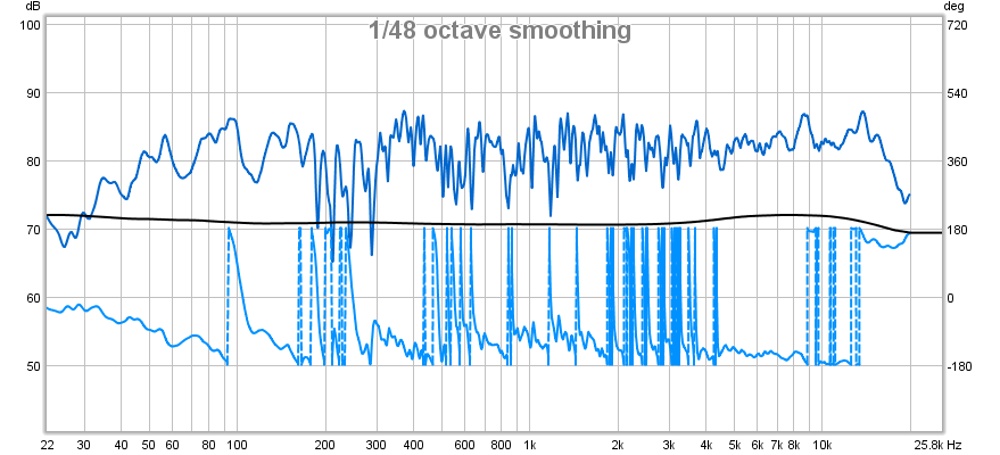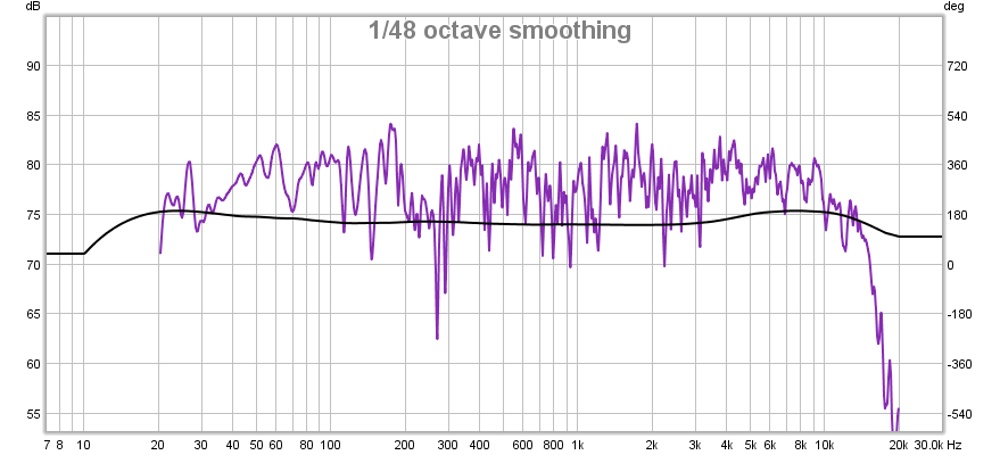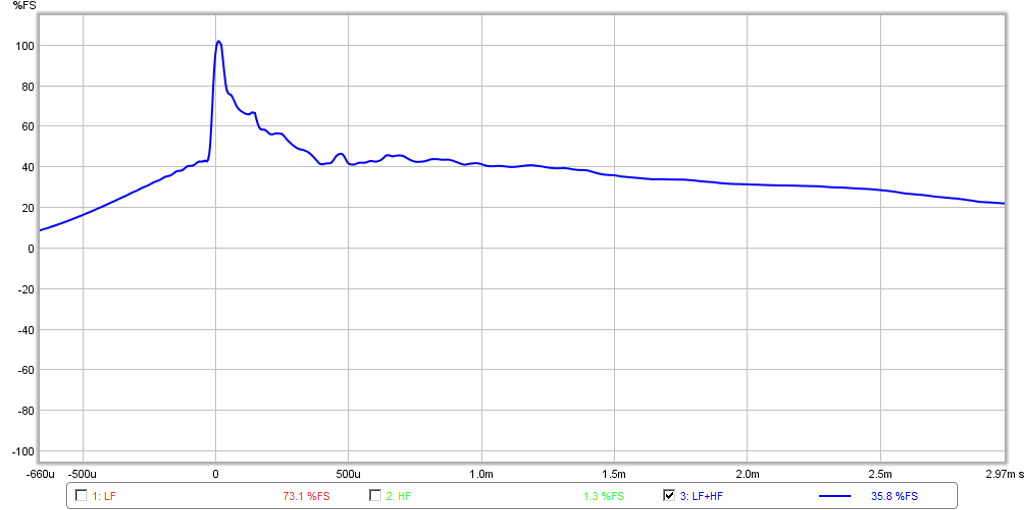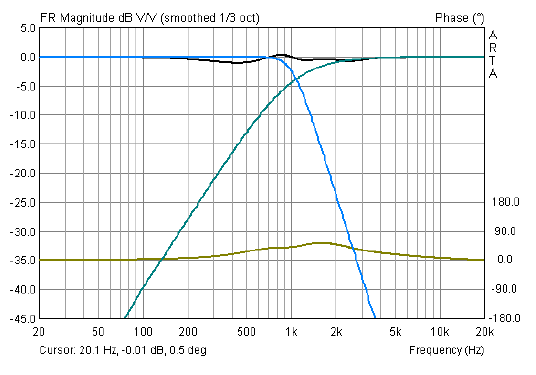Thanks 🙂, it looks better in pic than person, since i m not a patient guy,after building the box i went with vinyl instead of my first choice of veneering the whole thing. but i can always change it if ever.
anyhow, yes the reason it looks so flat is because of scaling of course, but overall the 2 drivers looks like a good combination since it relatively has almost flat respond without much tweaking.
I did try the Harsch XO, brought down the XO point to 500Hz, and with a few EQ I got this :

above is XO at 500Hz with Bessel for HF and Butterworth for LF with about 0.7ms delay for HF. Five Sweeps at 1m from speaker.
But as soon as i changed the Mic to listening position the FR was all over the place, nothing like 1m measurement, i m living in a relatively small flat but it was worse than i expected . but with importing REW settings to miniDSP and some tweaking around i got this :

I think the dip before 300Hz is perhaps baffle diffraction, and peak before 30Hz is probably the room.
anyhow, yes the reason it looks so flat is because of scaling of course, but overall the 2 drivers looks like a good combination since it relatively has almost flat respond without much tweaking.
I did try the Harsch XO, brought down the XO point to 500Hz, and with a few EQ I got this :
above is XO at 500Hz with Bessel for HF and Butterworth for LF with about 0.7ms delay for HF. Five Sweeps at 1m from speaker.
But as soon as i changed the Mic to listening position the FR was all over the place, nothing like 1m measurement, i m living in a relatively small flat but it was worse than i expected . but with importing REW settings to miniDSP and some tweaking around i got this :
I think the dip before 300Hz is perhaps baffle diffraction, and peak before 30Hz is probably the room.
haha, looks like it, your designs make sense and well documented. Thank you.xrk971 said:Looks like you have an all-XRK system going there with Alpha 20 and FH9
Attachments
Last edited:
Of course, measuring at 30cm is usually to set up the crossover, then you start playing with speaker positions, with the mic at the listening spot.
Once you find the right spot and the right XO curves and points, Look up on how to use biquads import in the miniDSP if using software like Sim, or FIR filters, if using RePhase.
Both will elevate your listening experience one more step from the built-in curves in the miniDSP.
Once you find the right spot and the right XO curves and points, Look up on how to use biquads import in the miniDSP if using software like Sim, or FIR filters, if using RePhase.
Both will elevate your listening experience one more step from the built-in curves in the miniDSP.
Thanks 🙂, it looks better in pic than person, since i m not a patient guy,after building the box i went with vinyl instead of my first choice of veneering the whole thing. but i can always change it if ever.
anyhow, yes the reason it looks so flat is because of scaling of course, but overall the 2 drivers looks like a good combination since it relatively has almost flat respond without much tweaking.
I did try the Harsch XO, brought down the XO point to 500Hz, and with a few EQ I got this :

above is XO at 500Hz with Bessel for HF and Butterworth for LF with about 0.7ms delay for HF. Five Sweeps at 1m from speaker.
But as soon as i changed the Mic to listening position the FR was all over the place, nothing like 1m measurement, i m living in a relatively small flat but it was worse than i expected . but with importing REW settings to miniDSP and some tweaking around i got this :

I think the dip before 300Hz is perhaps baffle diffraction, and peak before 30Hz is probably the room.
haha, looks like it, your designs make sense and well documented. Thank you.
You need to set the smoothing and windowing to FDW 6 cycles (this essentially allows you to look at the intrinsic speaker response independent of room reflections). Measure at 0.5m with mic on 10F/8424 axis. You are already elevated >0.5m so that will prevent any floor bounce from affecting measurement.
Here is where FDW is located:
Here is the dialog and click check box for FDW and set to 6:
Then measure the 10F only and SB23 only and the combined curves and plot on same graph. The phase should have a characteristic 55 deg rise bump at the XO freq if you did it right. It is tricky because you need to first EQ your woofer responses to fit the textbook 4th order low pass curve, then EQ the midtweet to fit the Bessel response high pass, then delay the midtweet by 1/2 the time of one period of the XO frequency. For 500Hz that is 1ms (plus any physical offset that the drivers have as woofer voice coil is typically 3in or so behind the tweeter, so tweeter needs about additional 3in of time of flight delay (220usec) or total delay of 1.22ms.
The curves should look like this with characteristic slight rise of woofer (or dip in combined response) to the left of the XO freq, and small 0.5dB wiggle as it goes through the XO like this:
The proof that it works is when your step response looks like it has the tweeter peak aligned with the leading edge of the woofer bump like this:

You will need to read the Harsch XO thread carefully - there was a recent example of how member mkane77g tried to get the Harsch XO working.
Here is the theoretically or textbook perfect Harsch XO as presented by Harsch himself:

If you have more questions, I would recommend posting questions in that the Harsch XO thread. Byrtt is really good at giving tips on how to make it work.
Attachments
Last edited:
Lets start from beginning, based on datasheet FR of SS and SBA I chose 700Hz as the XO frequency, I set the mic 1m pointing at SS and start measuring HF and LF separately based on 700Hz and after some tweaking around I came of with this as my first setting w 0.7ms delay on HF:
This is the original XO from my first post.

After reading a little on Harsch XO, I brought down the XO point to 500Hz and this was the results of my impression of Harsch :

2nd Attempt, I started from scratch, measured drivers individually and tried to match it to Harsch, after hours of tweaking, i came up with this :

this is 4 cycles measurement at 1m no EQ.
after this i moved the mic to listening position and start measuring and tweaking again, This is 2nd attempt Harsch with EQ:

Looks pretty reasonable, but for some reason this sound way off to me , weird like muffled at some point very harsh hf at some other point and lack of bass, it sounded much better without room EQ even though the FR is not flat at all, I tried to tweak more but i got tired and gave up for now and switched back to my original settings, this is the FR from listening position with REW EQ applied.

I will come back to this after more reading,.
This is the original XO from my first post.
After reading a little on Harsch XO, I brought down the XO point to 500Hz and this was the results of my impression of Harsch :
2nd Attempt, I started from scratch, measured drivers individually and tried to match it to Harsch, after hours of tweaking, i came up with this :
this is 4 cycles measurement at 1m no EQ.
after this i moved the mic to listening position and start measuring and tweaking again, This is 2nd attempt Harsch with EQ:
Looks pretty reasonable, but for some reason this sound way off to me , weird like muffled at some point very harsh hf at some other point and lack of bass, it sounded much better without room EQ even though the FR is not flat at all, I tried to tweak more but i got tired and gave up for now and switched back to my original settings, this is the FR from listening position with REW EQ applied.
I will come back to this after more reading,.
Attachments
Last edited:
Don’t be afraid to use the parametric EQ to flatten the native driver responses before using it on the XO. Use wide bandwidth cuts, not boost. Your mid tweeter response has a deep 7dB dip at critical 2.5kHz “presence” range. That’s why it sounds muffled. First apply EQ to get your driver to fit the curve on miniDSP exactly with nothing more than level adjust to get top height correct. It will take a shelf cut filter above 1kHz for the baffle step. Your woofer amp FH9 probably has more gain than Alpha amp so decrease woofer maybe 5dB to level match midtweet. That will bring more midrange presence back. The best way to do this is to use the built in EQ dialog in REW to capture your raw response and compare with textbook and play with PEQ (simulation) in REW and then when it matches, use the export to miniDSP function and it creates a PEQ curve file that then gets everything to work. It takes the guesswork and iteration out and does it in one try.
Thanks for the input, the puzzling part is that on paper my 2nd attempt Harsch should sound better but it doesn't to my ears.I switched back to my original settings and everything is there. it's probably my lack of patient and knowledge that i couldn't get the Harsch XO right, but i m gonna start from scratch again and stay away from textbook this time, from my days of mixing and mastering I do afraid of EQs in general, this time I will try to do some more EQs and trust my ears more, from my very limited experience a good example may not always apply on a certain situation.Don’t be afraid to use the parametric EQ to flatten the native driver responses before using it on the XO. Use wide bandwidth cuts, not boost. Your mid tweeter response has a deep 7dB dip at critical 2.5kHz “presence” range. That’s why it sounds muffled. First apply EQ to get your driver to fit the curve on miniDSP exactly with nothing more than level adjust to get top height correct. It will take a shelf cut filter above 1kHz for the baffle step. Your woofer amp FH9 probably has more gain than Alpha amp so decrease woofer maybe 5dB to level match midtweet. That will bring more midrange presence back. The best way to do this is to use the built in EQ dialog in REW to capture your raw response and compare with textbook and play with PEQ (simulation) in REW and then when it matches, use the export to miniDSP function and it creates a PEQ curve file that then gets everything to work. It takes the guesswork and iteration out and does it in one try.
Your last plot shows a series of dips, starting at ~1650 Hz, meaning something is causing this wobbly frequency response.
The plot has 20 dB division between the lines, which is a huge difference to the 5 dB scale that XRK used. While on this scale it may look relatively flat, it isn't within the plus/minus 2.5 dB of XRK's measurements. You're plus/minus 10 dB or more between 1500 and 5 KHz.
Look at your IR, that will show if there are any big reflections in your measurement that create that series of dips. It almost looks like a stereo measurement measured just outside the sweet spot.
The plot has 20 dB division between the lines, which is a huge difference to the 5 dB scale that XRK used. While on this scale it may look relatively flat, it isn't within the plus/minus 2.5 dB of XRK's measurements. You're plus/minus 10 dB or more between 1500 and 5 KHz.
Look at your IR, that will show if there are any big reflections in your measurement that create that series of dips. It almost looks like a stereo measurement measured just outside the sweet spot.
Last edited:
Don’t be afraid to use the parametric EQ to flatten the native driver responses before using it on the XO. Use wide bandwidth cuts, not boost. Your mid tweeter response has a deep 7dB dip at critical 2.5kHz “presence” range. That’s why it sounds muffled. First apply EQ to get your driver to fit the curve on miniDSP exactly with nothing more than level adjust to get top height correct. It will take a shelf cut filter above 1kHz for the baffle step. Your woofer amp FH9 probably has more gain than Alpha amp so decrease woofer maybe 5dB to level match midtweet. That will bring more midrange presence back. The best way to do this is to use the built in EQ dialog in REW to capture your raw response and compare with textbook and play with PEQ (simulation) in REW and then when it matches, use the export to miniDSP function and it creates a PEQ curve file that then gets everything to work. It takes the guesswork and iteration out and does it in one try.
Your last plot shows a series of dips, starting at ~1650 Hz, meaning something is causing this wobbly frequency response.
The plot has 20 dB division between the lines, which is a huge difference to the 5 dB scale that XRK used. While on this scale it may look relatively flat, it isn't within the plus/minus 2.5 dB of XRK's measurements. You're plus/minus 10 dB or more between 1500 and 5 KHz.
Look at your IR, that will show if there are any big reflections in your measurement that create that series of dips. It almost looks like a stereo measurement measured just outside the sweet spot.
I followed X instruction here and got good results. did get rid of dips after 1.6KHz, but i got series of dips at my LF FR now, not sure what causes such deep dips, any ideas ?
Getting IR is a good idea, i noticed the louder i do the sweeps more dips i get !
This is listening spot by the way.
Attachments
Last edited:
Try moving the speakers' position a bit, 30cm (or more) to the left, or to the right, forward and backward and look how it affects the FR
150Hz is classic floor bounce cancellation. Did you move mic to 0.5m and make sure mic is about 1m above floor? Then use 6 cycle FDW (which it looks like you might be doing already). Don't worry, it takes time to master this - not an easy concept actually to see that the individual driver responses must match the textbook profiles before you try to use them in the XO.
Another one that worked for me is simply 1st order like I did with passive.
Another one that worked for me is simply 1st order like I did with passive.
Try moving the speakers' position a bit, 30cm (or more) to the left, or to the right, forward and backward and look how it affects the FR
150Hz is classic floor bounce cancellation. Did you move mic to 0.5m and make sure mic is about 1m above floor? Then use 6 cycle FDW (which it looks like you might be doing already). Don't worry, it takes time to master this - not an easy concept actually to see that the individual driver responses must match the textbook profiles before you try to use them in the XO.
Another one that worked for me is simply 1st order like I did with passive.
I was all happy before seeing the FR from listening spot, lol.
mic is about a meter above the floor, and this FR is from 8-10Ft away, at 0.5 to 1m i almost get flat respond.
unfortunately i got no room to move the speakers around. but for now i did the final tweaking by ear and am happy with the results (REW room eq did not help , sounded weird).
I will do more sweeps hopefully in next few days.
... Byrtt is really good at giving tips on how to make it work.
Thanks comment although think your good help there covered most.
Thanks for the input, the puzzling part is that on paper my 2nd attempt Harsch should sound better but it doesn't to my ears.I switched back to my original settings and everything is there. it's probably my lack of patient and knowledge that i couldn't get the Harsch XO right, but i m gonna start from scratch again and stay away from textbook this time, from my days of mixing and mastering I do afraid of EQs in general, this time I will try to do some more EQs and trust my ears more, from my very limited experience a good example may not always apply on a certain situation.
Out at listening position be careful how to EQ but up front think there is no need to be afraid of EQ, the trouble is get 100% reliable measurement of only the direct driver sound, when that goal is reached then a exactly reverse curve of the non smooth acoustic response will pay back with a beautifully textbook looking impulse and step response plus waterfall will improve. A guess is for 10F when your measurements starts look close to dark blue below you on track and can start use reverse EQ corrections to get it smooth, other traces below is the gold one which is a traced copy of datasheet for 10F and light blue show simulation of your baffle step and diffraction using "The Edge", grey trace is example of a acoustic target curve BS2 at 500Hz up to a BW2 roll off at 18kHz.
Attachments
Last edited:
Out at listening position be careful how to EQ but up front think there is no need to be afraid of EQ, the ...
Hi Byrtt, thanks for reply, looking forward for your help to set this Harsch XO up.
My apartment was going under some treatment and repairs for past few days and hopefully I will start measuring today or tomorrow.
So from the start, I measured the drivers individually (1m distant, mic pointed at tweeter) and setup crossover, EQed to get a flat respond, and it worked, crossed at 700Hz, easy, i was happy with it until i start measuring the speakers from listening spot, my fault was that i was trying to get rid of room effect and reflections with moving around XO, different slobs, EQ... which to me it may look flat but it did not sound right at all (I know dumb idea, lack of experience).
Also, just to make thing worse for myself, instead of taking closer FR to eliminate reflections i decided to position the mic further away and start a crossover based on that reading, which is the dumbest thing ever, i was probably drunk and i m gonna tattoo that on my arm to remind myself of this brilliant idea.
Anyhow I managed to read more about Harsch XO and crossovers in general, will try this again and will report back in Harsch thread.
One thing tho, how do I get 12db Bessel slob in minidsp ? or is it only doable in HD version.
And also, X, do you ever tried your 10F/8424 & RS225-8 setup w miniDSP ? i mean do you ever achieve same or close results (TP XO or even Harsch XO) with miniDSP ?
Thanks.
A.
Last edited:
I started out with miniDSP with Harsch and got it to work well. I only moved to passive XO to use as test speaker for amplifier development.
Bessel in miniDSP is only one there and it is 12dB/octave.
Bessel in miniDSP is only one there and it is 12dB/octave.
Looking better. Can you show the crossover curves of woofer tweeter and combined? Also need to see phase in high resolution to see 55deg bump in phase at 500hz. Also impulse / step response.
I think you have it there. For step response choose %FS rather than dB. But the tell tale is the mild dip in combined below the woofer to the left of XO and your curves look like the right shape of 4th order and 2nd order Bessel. Good job.
How does it sound?
Listen to acoustic guitar, drums (rim shot), stand up bass etc. - crisp attack is the signature.

How does it sound?
Listen to acoustic guitar, drums (rim shot), stand up bass etc. - crisp attack is the signature.
Last edited:
I think you have it there. For step response choose %FS rather than dB. But the tell tale is the mild dip in combined below the woofer to the left of XO and your curves look like the right shape of 4th order and 2nd order Bessel. Good job.
How does it sound?
thanks, and it sounds "right" ! very pleasing 🙂
what do you suggest ?
Attachments
- Home
- Loudspeakers
- Full Range
- 10F/8424 & RS225-8 FAST / WAW Ref Monitor

















